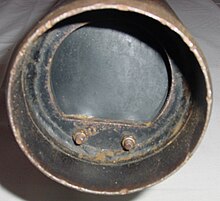Gravel pump
Gravel pumps , even gravel rifles called gravel pumps and Plunscher are also called valve drill summarized and used for digging deep holes and wells . Initially developed for manual use, they were later driven in larger versions with mechanical power.
The devices essentially consist of a tubular pump body, the lower end of which is usually formed by a non-return valve (bottom valve). They are suitable for digging (well) shafts in water-bearing rolling soils and loose rock .
In other soils, manual drillings were previously carried out with pocket drills .
Mode of action
The gravel pump can only be used under water, as otherwise insufficient negative pressure and no current to transport the material can be generated. There must therefore already be a water-filled hole in the ground.
By quickly lifting the piston over the piston rod and the rope or chain attached to it, a flow of liquid is generated below the pump, which flushes gravel or sand and sucks it into the pump body.
As with a lever pump, there can be one valve flap in the piston and another in the bottom of the cylinder.
If the gravel pump is filled with gravel or sand after pressing the piston once or several times, it is pulled out of the well hole or well pipe to empty it. The contents are emptied through a side opening on the pump body.
With a gravel pump, the water-sand mixture is sucked into the pump body by actively sucking the piston (similar to a piston pump ) , compared to a plunscher.
Gravel pumps are not to be used to drill the ground, as they would loosen up the grown soil in the area of the borehole.
Gill sand pump
This sand pump was used to sink shafts or wells to great depths (sinking).
Boiler wells were built on wooden, iron or reinforced concrete wreaths and sunk using sand pumps. The dead weight and conical tapering of the shaft well made this possible.
If the ground was too firm and stony, the withstand wreaths had to be sunk instead.
functionality
The sand pump was lowered into the shaft well (boiler well) with the help of slings (chains) until the pipe t, which was open at the top and bottom, reached the bottom of the well. A so-called pump boot (piston tube ) h is mounted on the cover of the cylindrical housing g and communicates with the interior of the sand pump and is open at the top.
As with the gravel pumps commonly used today, there is a movable piston in cylinder h . When the piston is pulled, a water / sand mixture penetrates into the inner space of the sand pump via the tube t .
By redirecting and slowing down the flow it is achieved that heavy components from the water flow collect in the settling tank. When the piston lowers again, the water escapes through the flap valves i attached to the cover g .
By loosening the hooks f , the floor could be lifted off for quick emptying.
Plunscher (spoon, mud can, gravel can)
In contrast to a gravel pump, the Plunscher does not have a piston, only the non-return valve at the lower end of the cylinder.
The pluncher is lowered to just above the bottom of the well, where it can be suddenly filled, pulled up and dropped again.
A valve drill is u. a. set in an upward and downward movement by means of a rope hammer, whereby it gradually fills with material that has been blown up.
Individual evidence
- ↑ Drilling tools guided on a rope, gravel pump at books.google.de, accessed on July 26, 2014
- ^ Journal for the mountain huts and saltworks in the Prussian State, Verlag Ernst & Korn, Berlin 1871, p. 26
- ↑ Drilling tools guided on a rope, valve drills on books.google.de, accessed on July 26, 2014
Manuals
- Gravel pump / Plunsche instructions on Erdbohrer.de, accessed on June 10, 2014
- Gravel Pump Instructions , accessed July 29, 2014.


